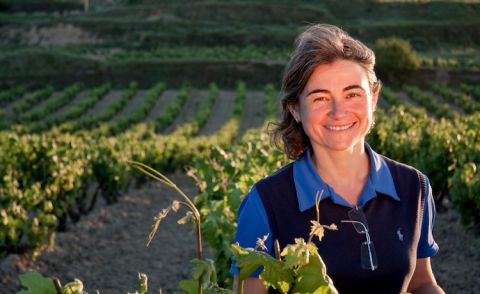An unusual old favourite revisited. Look out for Jancis’s article on white rioja next week for a range of other examples.
2010 from €24.20, HK$266, 142 Romanian lei, £26.99, 3,800 roubles
2011 from €24.90, 27.90 Swiss francs, £22.90, $39
2012 from €28.90, £24.95, $38
Last time Jancis chose this traditional white rioja Viña Gravonia as a wine of the week was back in 2014 and the vintage was 2004. I remember rushing to buy a case of six because it was such good value for a mature wine, and I still have one bottle in my cellar, for ‘research purposes’. Sometimes I think López de Heredia’s wines are indestructible, although Viña Gravonia may be slightly less so than its senior sibling Viña Tondonia, which comes in red, white and rosé. So deliciously recognisable is this wine – once tasted, never forgotten – that I reckon it would have been a banker when it cropped up in the 2018 MW blind tasting exam.
Tradition can be stifling or both reassuring and joyous. In this case, it is definitely the latter – an oxidative style of white rioja, one that is exposed to more oxygen than most white wines during fermentation and ageing, that is becoming increasingly rare; what Jancis referred to as ‘a nearly extinct species’. Marqués de Murrieta used to make a wonderful white gran reserva but their current white offering is the well-made but less interesting Capellanía, which highlights the fruit and is aged for a much shorter time in much younger oak barrels.
Viña Gravonia comes from the 24-ha (59-acre) Viña Zaconia vineyard. It’s right by the winery on the banks of the River Ebro in Haro, mapped in detail in this World Atlas of Wine map, and was bought by the great-grandfather of the current generation, sisters Mercedes and María José López de Heredia. Vines are on average 30–40 years old and planted on poor, gravelly, south-facing calcareous-clay slopes with very good drainage.
The character of this wine, however, is as much about the winemaking – in particular the fermentation in centenarian oak vats and four years’ ageing in 8- to 10-year-old American oak barrels – as it is about the vineyard. López de Heredia are rightly proud of the fact that they have their own cooperage, and this presumably allows them to look after their barrels into old age, giving them the option of ageing this wine oxidatively but without it picking up excessive oak flavour from new or newish barrels. Fermentation is spontaneous, and the wine also spends time in vat between barrel and bottle. The wines are fined with fresh egg whites but not filtered. There’s really no need to filter after so long in the barrel, which results in clarity and stability.
Viura, also known as Macabeo (and as Maccabeu in France’s Roussillon), is northern Spain’s most planted white grape variety and can yield rather neutral wines but it is very well suited, as here at López de Heredia, to barrel ageing and even longer ageing in bottle. As the wines age they develop fascinating and distinctive tertiary flavours such as cedar, honey (though not sweet), beeswax, linseed, sometimes bitter orange. It’s the sort of wine that elicits many different descriptions because it is actually quite hard to put the aromas and flavours into words. Best just to pour it, inhale the complex aromas, then enjoy it as it fills your mouth and continues to change in the glass. An added bonus is the moderate alcohol of 12.5%.
It’s always a treat to enjoy mature whites that benefit from bottle age, as opposed to those that get forgotten at the back of the cupboard and end up down the sink, and you may well find even older vintages still available. I loved all three of the vintages I tasted for those bottle-aged flavours: the 2010 clearly the most developed of the three, seeming slightly more than a year older than the 2011, in which the oak showed a little more obviously on the palate. The 2012 had the highest acidity, making it both the freshest and probably giving it the greatest ageing potential – at least another five years in bottle and probably longer. But there’s no hurry to drink any of these provided they have been well stored.
But don’t let me give you the impression these wines have lost their fruit. They haven’t. There’s a thread of citrus and green fruits running through the wines, the 2010 showing more bitter orange, the 2012 more lemon and lime, the 2011 hovering in the middle.
You can see longer descriptions and background to the vintages in my tasting notes on 2010, 2011 and 2012.
There’s tradition not just in the style of the wine but also in the bodega (pictured at the top of this article), begun in 1877 and now the oldest in Haro. It is still in the same family ownership. The company Viña Tondonia was founded in 1913–14 and their vineyards now cover more than 100 ha (247 acres), making the producer unusual in Rioja in having its own grape supply rather than buying in grapes.
Whichever vintage you can lay your hands on, don’t miss out on this increasingly rare, well-priced treasure.
The wine is available in the UK, the US and Europe, and can also be found in Hong Kong and Russia. While López de Heredia describe 2012 as ‘the current vintage’, the fact that it ages so well means that you will often find several vintages on offer in the same country, including even older examples than the three I have described here. (Wine-Searcher shows vintages back to 1960.)
See our tasting notes database for vintages of Gravonia back to 2002 and for many more on Viña Tondonia red, white and rosé.
Photo of the López de Heredia winery © Archive Bodega Lopez de Heredia Viña Tondonia.



